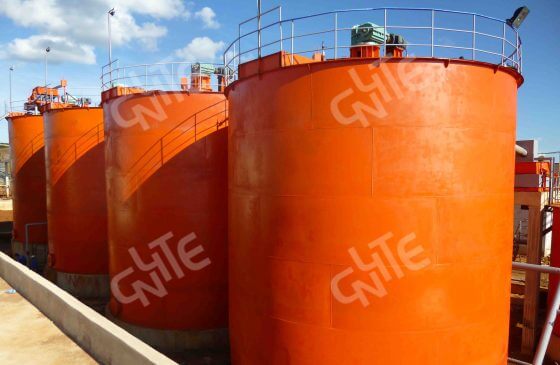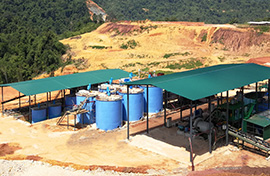-
 E-mail
guhaixin0724@gmail.com
E-mail
guhaixin0724@gmail.com
-
 Call Us
008613683147042
Call Us
008613683147042
 E-mail
guhaixin0724@gmail.com
E-mail
guhaixin0724@gmail.com
 Call Us
008613683147042
Call Us
008613683147042
2019-10-18 Views: 6275
Warm Tip: If you want to know more information, like quotation, products, solutions, etc., please Click here ,and contact us online.

With the continuous development of gold production and the rapid development of gold resources, the process of agitation gold leaching is also improving day by day, and has been widely used.
The agitation leaching method is to concentrate the slurry, obtained after grinding and classifying of the gold-containing ore, to a suitable concentration, place it in a leaching tank, add a cyanide solution, and aerate to carry out leaching. The main equipment used in the agitation leaching process is a cyanide leaching tank. According to the different mixing methods, cyanide leaching tanks are divided into three types:
1. Mechanically agitated leaching tank, a leaching tank commonly used in cyanide plants.
2. Air agitated leaching tank, utilizes the aerodynamic action of compressed air to agitate the slurry.
3. Air-mechanical combined agitation leaching tank, a perfect combination of the two leaching tanks (1) and (2), with both effective mechanical and compressed air agitator. The fast dissolution of gold is the main advantage of this device.
Agitation leaching is suitable for process materials having a finer particle size, i.e., less than 0.3 mm. The advantages of this method are: high leaching speed, large processing capacity, mechanized operation, and high gold extraction rate. This conventional cyanidation method is one of the more widely used methods in the gold cyanidation process. According to the different ores processed, it can be divided into: the whole mud cyanidation method for directly processing gold ore, and the concentrate cyanidation method for process gold concentrate.
The process of the agitation leaching process comprises the following steps:
1. Preparation of leaching raw materials
2. Agitation leaching
3. Washing solid-liquid separation
4. Clarification and deoxidation of pregnant solution
5. Replacement precipitate
6. Smelting ingot
For general non-sulfide gold-bearing ores, it is usually grind to 60-70%-200 mesh. Cyanide is added to the grinding operation, and side immersion is performed to improve the leaching efficiency.
For sulfide gold-bearing ores, flotation enrichment is often used. Or separating out some gold-bearing sulfide concentrates from flotation concentrates, such as gold-bearing copper concentrates, and finely grinding them to 90%-95%, -325 mesh to shorten the leaching time and improve the leaching efficiency. For ore with higher arsenic or pyrrhotite, flotation concentrate ore roasting desulfurization or arsenic removal is carried out, and then the calcine is cyanated and leached. Ore with higher carbonaceous minerals, chlorinated and then leached.
The pulp is generally leached at a concentration of 35% to 50%, and the pH is adjusted to be between 10 and 10.5 to prevent decomposition of cyanide and inhibit the cyanidation of the sulfide. The concentration of cyanide is usually maintained at about 0.06%, and the mixture is agitated under oxygenation conditions for 24 hours or more, so that 95% or more of gold is dissolved to form a gold cyanide complex.
In order to obtain sufficient separation between the cyanide leachate and the leach residue, a washing process of 3-5 stages of thickening, filtration or a mixture of the two is generally employed. This is a key operation for cyanide leaching, which often results in a decrease in recovery rate due to the difficulty in selecting or incompletely separating the mud.
Maintain a high replacement rate and high grade gold mud, mainly using a clarification filter to reduce the suspended matter in the leachate from 70-100ppm to 5-7ppm, and deoxidize by vacuum to reduce the oxygen content in the solution to less than 1ppm.
The gold cyanide complex in the leaching solution is replaced with a metal to form a cyano complex of the replacement metal to precipitate gold. In order to obtain a more effective displacement reaction, a lead salt of about 0.005% is maintained in the solution, and the oxygen content in the solution is minimized to prevent oxidation of the zinc surface and reverse oxidation of the displaced gold, and precipitate the gold mud. Residual metal in the middle. It is removed by pickling to maintain a high-grade gold mud with a gold content above 30%.
The gold mud and the flux are generally smelted and slag at a furnace temperature of 1000-1100 degrees Celsius for about three hours at a ratio of 1:0.8-1 to obtain a gold ingot having a gold content of 95% or more.
The zinc powder replacement method is the most used metal replacement method. Zinc powder is a very fine metal substance that provides favorable conditions for more complete and faster precipitation of gold. However, zinc powder is easily oxidized and must be tightly closed during transportation or storage.
According to the different replacement methods in the separation stage, the agitation leaching method can be divided into two types of processes: metal replacement and carbon adsorption: The metal replacement is a so-called conventional cyanidation gold extraction process (CCD method and CCF method) which performs continuous countercurrent washing with a thickener and replaces the precipitated gold with zinc powder. Carbon adsorption is a non-filtered cyanide carbon slurry process (CIP method and CIL method) that does not require filtration or washing, and uses activated carbon to directly adsorb gold from cyanide pulp.
Since the 1980s, the agitation cyanidation method has achieved good results in the gold extraction process in the actual production process of gold.
After the civil engineering, installation and commissioning of the process design, it has been put into operation. Finally, the CIL gold leaching rate is 91.5%, which brings considerable economic benefits to the mine owner.
After the crushing and grinding stage of the CIL gold ore process, the slurry is added to 9 Xinhai high-efficiency cyanide leaching tanks arranged in a stepped manner. The cyanidation of the gold slurry is first carried out in the first 2 leaching tanks, and adding activated carbon to the countercurrent adsorption operation while performing cyanidation in the subsequent 6-7 leaching tanks.
Compared with the CIP gold mining process and other traditional processes, the CIL gold mining process of the plant greatly shortens the cyanide operation time. Taking the 7.5g/t gold ore cyanide plant with a capacity of 100,000 tons per month as an example, the CIL carbon leaching method saves investment costs of 486,000 US dollars compared with the CIP carbon slurry method, reducing the backlog of gold retention in production of 210,700 US dollars. After deducting the cost of the $12.60 million spent on activated carbon, the savings and early recovery of funds were $675,100.
In the process of adding activated carbon, the imported coconut shell activated carbon (small hole, high activity, wear resistance and regenerability) specially selected by the plant's ore dressing design institute is added to the pulp, and the gold-loaded carbon appears with the gold and silver ions are dissolved and adsorbed by the characteristics of adsorbing gold and silver. This process does not affect the dissolution of the process due to excessive ion concentration, greatly improving the recovery rate of precious metals such as silver and copper in the associated metals, and significantly improving economic benefits.
The vibration and dewatering equipment is the key equipment for the reverse movement of pulp and carbon. The hydraulic filter press and high-efficiency high-frequency dewatering screen designed by the plant can effectively reduce the carbon wear of the slurry on the continuous pumping and vibrating screen surface and reduce the cost. Easy to maintain operations.
The central aeration riser used in the mixing process can make the slurry a small cycle. Compared with other mechanical agitation tanks, Xinhai's design can reduce the power consumption by 70%, and the solid materials are uniformly suspended, and the activated carbon wears little. The recovery rate is high. It is an important equipment in modern cyanide plants.
The integrated operation desorption electrolysis system of the plant uses high-temperature desorption electrolysis of gold in gold-loaded carbon using a mixture of sodium cyanide and sodium hydroxide. First, the wood scraps and other debris are removed by a pan wash, and then the gold desorption is performed at a temperature of 150 ° C and 0.5 Mpa using a high temperature and high pressure desorption method. This design can put 99% gold in 2-6 hours desorption down.
The concentration of gold and silver cyanide complex ions in the pregnant solution obtained by desorption of gold-loaded carbon is higher, and the impurity ions are greatly reduced. It provides an ideal solution for the reduction and recovery of gold from the noble liquid by electrowinning method. The high-purity solid gold can be obtained safely and economically by the treatment of the desorption electrolysis system.
No. 188, Xinhai Street, high-tech Industrial Park, Fushan District, Yantai, Shandong, China.

Please leave your message here! We will send detail technical info and quotation to you!